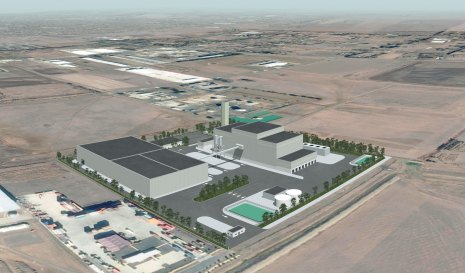
Two industry sources, speaking anonymously to detail confidential discussions, said draft versions of the government’s upcoming Economic Growth Statement had included provisions to lift this cap, potentially paving the way for more facilities.
Residents, the Geelong Chamber of Commerce, and the City of Greater Geelong have raised concerns the facility at Lara in Melbourne’s west, which would burn a combination of residential, commercial and industrial waste, would generate offensive odours and air pollution.

An artist’s impression of the proposed Prospect Hill International waste to energy plant in Lara.
Marles, the Corio MP, wrote to Kilkenny in July adding his support to community opposition to the project.
“It is paramount to note the facility would be located only 1200 metres from Lara’s town centre, with the closest home a mere 350 metres away,” Marles wrote. “It is clear the community does not support this project.”
Bellarine Labor MP Alison Marchant, Corangamite MP Libby Coker, Geelong MP Christine Couzens and Geelong business leaders also oppose the project.
George said she did not support the incinerator in her electorate and raised residents’ concerns with relevant ministers.
Local developer Richard Bisinella, whose family business plans to deliver 300 new housing lots over the next five years near the incinerator site, wrote to Premier Jacinta Allan on Monday raising fresh concerns about the modelling used to justify the project.
He commissioned a report by environmental consultants Peter J. Ramsay and Associates, which argued the actual C02 emissions from the facility would be 420,000 tonnes a year, rather than the 192,000 tonnes forecast.
This is partly because, they argue, the assessment process failed to account for the amount of organic waste entering the incinerator, which would increase greenhouse gas emissions.
Loading
Bisinella argues this would mean the project would more than double the 200,000-tonne emission threshold to trigger an environmental effects process, which was not required as part of the original permit process.
He said: “200,000 tonnes of carbon is a significant amount of pollution in anyone’s language, and 400,000 tonnes is a whole new matter.
“Given the sensitivities, the location of the project and the legitimate concerns of the community, environmentalists and politicians on all sides, surely an EES [environmental effects statement] should have been required in this case.”
There have also been concerns raised about whether the site would have to import waste to meet its demands, with Geelong council indicating it would not sign contracts with the operator.
Freedom of information documents obtained by community opponents also purport to show pressure from the government to approve the Lara project.
In one email sent to the Environment Protection Authority, a representative of the project’s proponent described Victoria’s planning minister as wanting the EPA to “wrap up this application as soon as possible” and suggested the department “may refuse the planning permit application because of the uncertainty with the development licence process”.
In another email sent to the EPA, a Department of Transport and Planning official requested an update on the “approval” of the development licence, writing: “We are keen to get the decision moving on the planning permit so we are hoping to get an understanding of time frames and where the decision is up to as soon as possible.”
EPA Victoria chief executive Lee Miezis said the agency had approved Prospect Hill International’s development licence application for the Lara site in December.
That decision had since been appealed to the Victorian Civil and Administrative Tribunal and was listed for hearing in 2025, meaning the EPA was unable to comment further on the matter, he said.
A government spokesperson said: “The EPA’s development approval is one of many steps required in the approvals process, giving the community more opportunities to have their say on the proposed project.
“Any proposal will be considered on its merits and every submission will be considered as part of the assessment process.”
A Prospect Hill International spokesperson said the approval of its application for a development licence was the result of almost three years of rigorous environmental assessment by the EPA.
“This project will process waste which currently cannot be reused or recycled and that would otherwise go to landfill,” they said.
“Diverting this waste from landfill, the project will assist in reducing large amounts of greenhouse gases from entering the atmosphere, as well as avoiding other negative impacts of landfills.”









 Add Category
Add Category